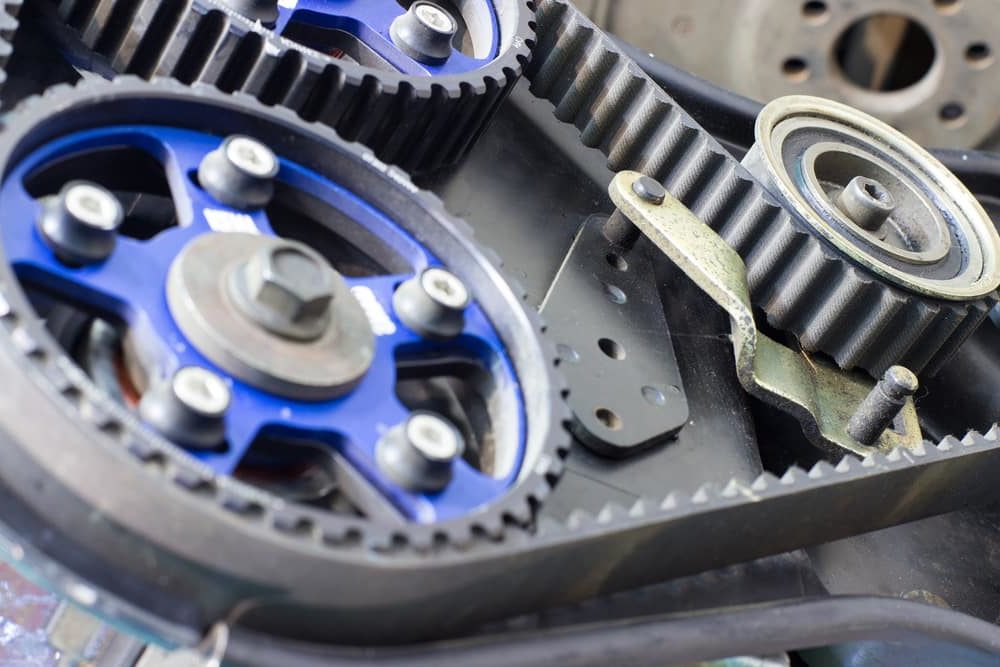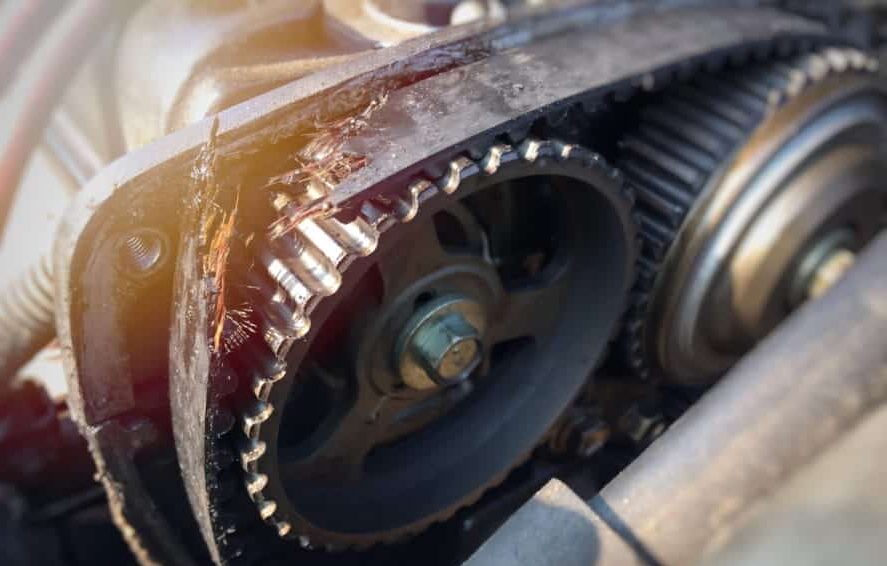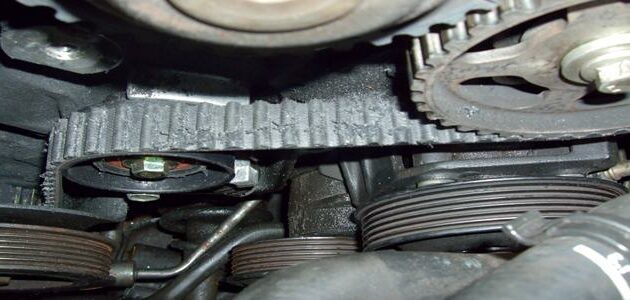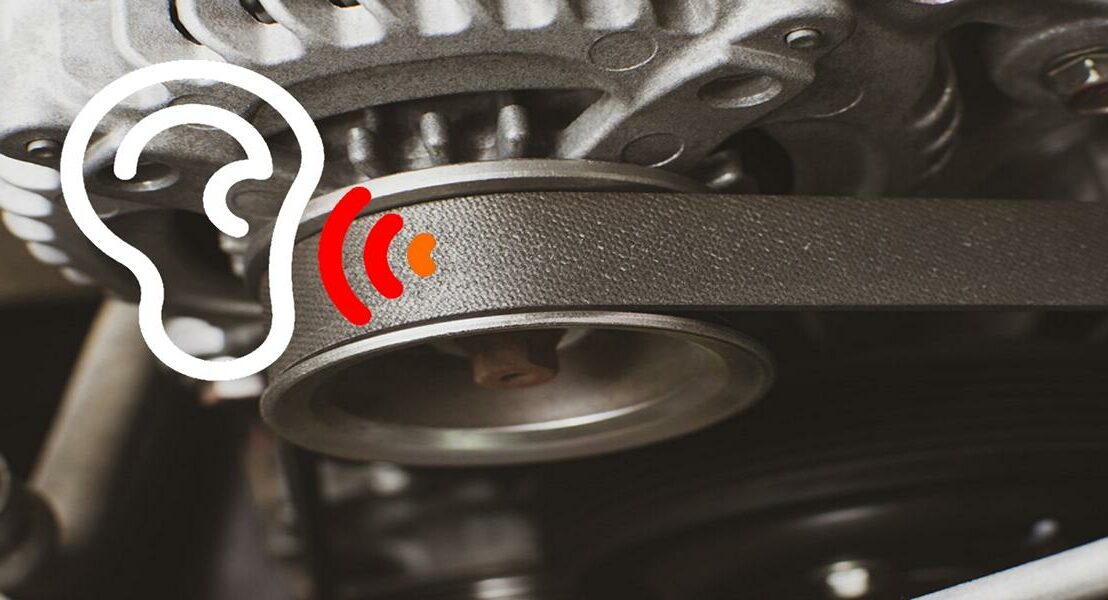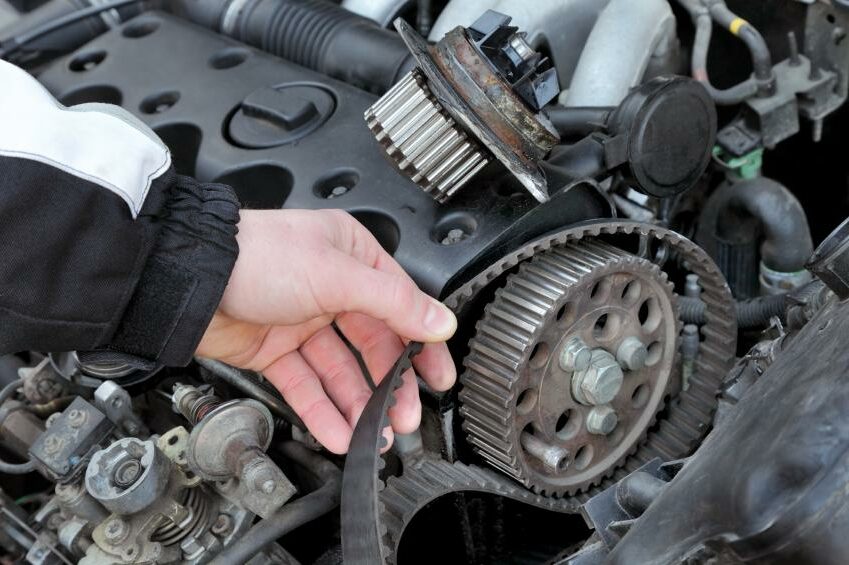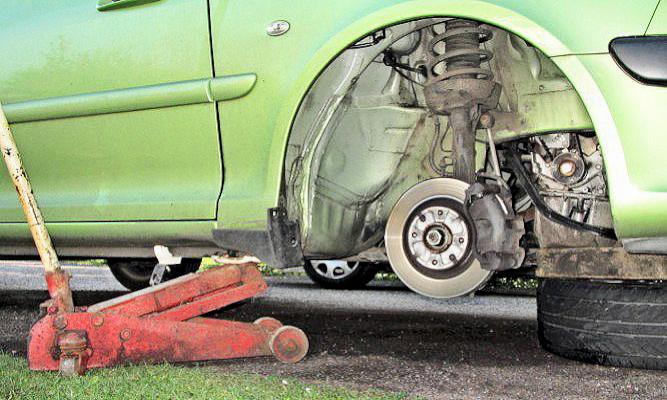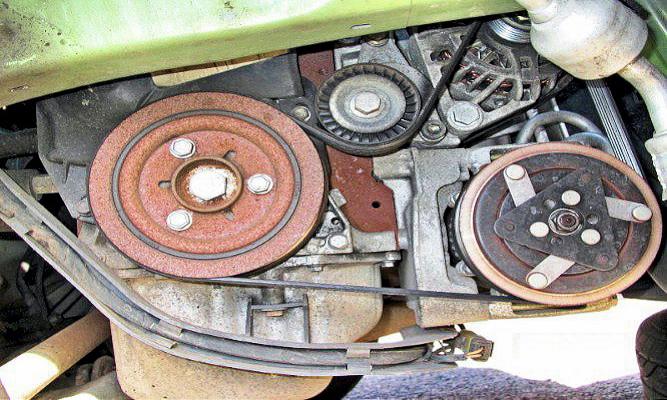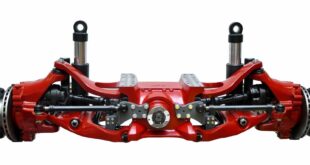Recently updated on January 27, 2022 at 10:35 am
The timing belt is an important element im Engine of the vehicle. It establishes the connection between the crankshaft and camshaft. This ensures the synchronicity between the crank drive and the inlet and outlet valves. But not every combustion engine has a toothed belt. Often the power is transmitted via a timing chain. Due to the material used, the toothed belt is subject to a certain amount of wear. It is therefore necessary to replace it at regular intervals to prevent engine damage. The following guide is about when it is necessary to change the timing belt, how complex the service is and what costs are associated with it.
Changing the timing belt: when, why, what costs?
 Who is only interested in very specific areas around the topic "Changing the timing belt: when, why, what costs?" iIf you are interested, you can use the following jump labels to navigate directly to the desired topic with just one click. And just as quickly you can return to this overview from the selected menu item with just one click. However, we recommend our readers to always read through the entire article. Some menu items are only really comprehensible and understandable once the complete information article has been read.
Who is only interested in very specific areas around the topic "Changing the timing belt: when, why, what costs?" iIf you are interested, you can use the following jump labels to navigate directly to the desired topic with just one click. And just as quickly you can return to this overview from the selected menu item with just one click. However, we recommend our readers to always read through the entire article. Some menu items are only really comprehensible and understandable once the complete information article has been read.
- When should a timing belt be changed?
- Signs of an upcoming toothed belt change
- Symptoms of a broken toothed belt!
- How is the timing belt changed?
- Two timing belts are unusual, but possible!
- Time required: changing the toothed belt
- Timing belt change process!
- Costs of changing the timing belt
- Toothed belt or V-belt?
- Changing the timing belt, what should you watch out for?
- disposal
- summary information
When should a timing belt be changed?
First of all, if the timing belt breaks, it is definitely too late to think about changing the timing belt. Therefore, it is imperative to adhere to the manufacturer's prescribed replacement intervals. It applies to the timing belt rather a little earlier change when it is too late and the engine is damaged. The manufacturers actually give exact details for each type of engine Change intervals for the toothed belt. However, these vary greatly in detail. You can read the interval in the service book of the vehicle.
Usually the exchange range is included 90.000 km up to 200.000 km Mileage or between 4 and 10 years ago. Newer engines have a clear one here higher Change interval than older models. This is due to the fact that the auxiliary units such as the water pump in the new engines not directly are driven via the toothed belt, but indirectly via a V-ribbed belts. This greatly reduces the load on the toothed belt. The materials are also designed to be much more robust in newer engines.
A toothed belt does not only have to be changed for high mileage. Even with vehicles with very low mileage you should keep an eye on the timing belt. Because over time this becomes porous. If you don't change a porous belt, rips this is guaranteed in the further course.
Rule of thumb: the timing belt every six years switch unless the prescribed one Mileage will be earlier reached. The timing belt is also checked as part of the mandatory vehicle maintenance and inspection. Here is mostly a visual inspection Fraying and cracks performed. Also the Belt tension is controlled. A toothed belt that is too loose can quickly slip and negatively affect the engine setting and, in the worst case, to engine failure to lead. Therefore, it is better to change a timing belt earlier than expensive engine damage later. "back
The following signs indicate that a toothed belt change is due:
- The manufacturer's prescribed replacement interval has been reached.
- inexplicable grinding noises
- The toothed belt has already torn. There are enormous additional costs to fear from consequential damage!
- The engine run is unusual. Of course, this can also have other reasons, but porous and cracked belts also have a negative effect on engine running
- The timing belt is very oily. Usually a defect in the valve cover gasket or a crankshaft oil seal is leaking.
Here the toothed belt should be replaced directly. "back
Symptoms of a broken toothed belt!
The toothed belt will not tear when the engine is switched off, only under Last. For example when starting. And you can tell such a crack from the fact that the engine goes out and may sound unusual. Does the vehicle have a so-called Freewheel motor, then a broken toothed belt leads not to further damage. All other types of engines are usually scrap afterwards or at least close to it. And if the toothed belt breaks, the motor stops rinse and often unevenly. As a result, the camshafts stop and the valves are no longer controlled. The trailing pistons then almost always hit the open valves. This is usually expressed by a loud pops. Crooked valves, broken camshafts and destroyed cylinder heads are the result.
Note: An incorrectly installed toothed belt can cause the same damage as a broken one. "back
How is the timing belt changed?
When it comes to timing belts, a complete change is the only option. A belt repair can not. The toothed belt is one of the wearing parts of a vehicle and an engine. If the toothed belt is replaced, it makes sense to do all of them at the same time Tension pulleys, guide rollers and V-ribbed belts to exchange with. The tension pulley in particular is an important component. Because of this, the toothed belt always has the correct tension. Here the break of the tension spring is enough and the belt loosens.
Should the pulley block, the toothed belt will heat up and, as a result, it will tear quickly. Depending on the vehicle model, other components are also replaced when the toothed belt is changed. In older engines, the timing belt is usually tensioned using the water pump. Especially here it is a good idea to exchange the water pump directly. For these reasons, spare parts manufacturers offer specially tailored ones Timing belt sets / timing belt kits on. In addition to the toothed belt for the corresponding vehicle, all other wear parts are also included here. "back
Tip: In our post "Improved timing belt, pulleys and camshaft gears!“There is some information about particularly high-quality timing belt sets.
Multiple timing belts are unusual, but possible!
Mostly there is only one per vehicle / engine a Toothed belt installed. But here too there are exceptions. the VW T4 2.5 TDI or the Honda Prelude with F20A engine have, for example, two toothed belts. One belt controls the injection pump, the second the camshaft on the VW. In the Honda, one drives the camshafts and the other (small) drives two balance shafts, which are supposed to compensate for the vibrations of the engine and ensure smoother running. If the small belt breaks on the Honda, this is less dramatic, as it is only responsible for smoother running. The same applies to the belt for the injection pump on the VW. The other two straps are against it irreplaceable and should by no means tear! "back
often time-consuming change from the toothed belt
Changing the timing belt usually takes a lot of time. Because the timing belt runs due to the design very close to the engine. This makes it difficult for the fitters to reach. Depending on the position of the engine in the vehicle (lengthways or crossways), other components may first have to be dismantled in order to even get to the toothed belt. With engines installed lengthways, it is usually necessary to also dismantle the front bumper including the cooler package including the fan wheel. As a result, the ribbed V-belt, the timing belt covers, the crankshaft pulley & tensioning pulley, the deflection pulley and the water pump must be dismantled.
If the engine is installed transversely, it is usually sufficient to remove the front right wheel including the wheel arch trim. Then the process after dismantling the ribbed belt is similar to that described above. Unfortunately there are even engines that drained oder sogar expanded must be in order to enable the timing belt change. Such vehicles are rare, but it is completely out of the question not! "back
Procedure when changing the toothed belt!
When changing the toothed belt, it is important that the toothed wheels turn on after the new belt has been installed exactly the same position as before to stand. Therefore, the crankshaft and camshaft are also made with special tools pinned. This blocking ensures that the The engine timing cannot be adjusted. The replacement of the toothed belt should therefore only be carried out by experienced screwdrivers and is not a job for the evening in your own garage for a short while. In addition, for this work is mostly special tools are required for operation.
The fact is: One cannot write universal instructions for changing the toothed belt. The vehicle engines and their installation positions (front, middle, rear engine, lengthwise or crosswise, V, row, boxer engine, etc.) are simply far too different.
Grob it can still be shown as follows:
- Find out the position of the toothed belt in the motor. (Operating manual)
- Expose the toothed belt to create enough space to work.
- Set the motor to top dead center (TDC) (pay attention to the direction of rotation of the motor and the markings)
- Block the engine from cranking. (using special pins or clamping blocks / depending on the type)
- Now loosen the tension pulley and remove the belt. (Photos of the course of the toothed belt helps)
- Replace and install the complete parts of the timing belt set.
- Now put on the belt and then tighten the tension pulley. (Note torque)
- Now turn the engine by hand in the direction of rotation. (everything must run freely)
- Is the water pump driven by the V-belt? Then switch both, if possible.
- Now reassemble the vehicle in reverse order.
- Attach notes for the next change of the toothed belt so that they are clearly visible and note them in the service booklet. "back
Cost of a toothed belt change
There is no flat rate for the cost of a timing belt change. The total cost can vary widely. The largest share, however, is the workshop's labor costs. The actual spare parts, on the other hand, are very inexpensive. Although individual parts such as pulleys are available for less than 10 euros, a complete exchange kit is usually the better option. Well-known manufacturers of such change sets are, for example, Continental (Contitech), Bosch, Gates, Mapco, skf or Dayco. Such sets are usually between 80 euros and 300 euros. However, costs of around 500 euros may be necessary if a new water pump is still included. These prices only refer to the spare parts.
With a new water pump, there are also costs for new ones cooling water added. Around 8 to 10 euros per liter. For engines that require an average of three to five liters of cooling water, this sum is also between 25 and 50 euros. Since the amount of work depends heavily on the type of engine, an average of two to five hours of working time are required for the change. At an hourly rate of around 100 euros, that adds up to pure labor costs of 200 euros up to 500 euros. Independent workshops often have one here, however lower hourly rate as authorized workshops. Nevertheless, costs of at least 300 euros up to more than 1.000 euros or even more quickly arise. "back
Toothed belt or V-belt?
V-belts, now called ribbed V-belts, or toothed belts differ greatly in their function and construction. During the timing belt the force is synchronized passes on, i.e. drives the camshaft and crankshaft synchronously, the V-ribbed belt drives the auxiliary units such as the alternator or air conditioning compressor. However, both belts can be responsible for driving the water pump. That depends on the type of engine. Normally, however, a defective V-belt is not as serious as a defective toothed belt. "back
Changing the timing belt, what should you watch out for?
- Timing belts should be about every 30.000 km geprüft be (inspection or maintenance)
- Observe the manufacturer's maintenance and replacement intervals (warranty claims)
- When buying a used car, pay attention to the timing belt change!
- When changing the toothed belt, also replace all attachments.
- Inquire about and compare prices for changing the toothed belt at various workshops. "back
Disposal of the old toothed belt and the attachments!
Completely different materials such as metal, rubber and plastic are used. If everything can be neatly separated, it can possibly be disposed of with household waste (if this is permitted). However, it is better to have everything closest to you Recycling yard bring to. "back
Summary information on changing timing belts - replacement / repair, replacement intervals, costs:
- the toothed belt establishes a connection between the crankshaft and camshaft
- the toothed belt ensures synchronicity between the crank drive and the inlet and outlet valves
- not every motor has a toothed belt, instead there is one timing chain installed
- the toothed belt must be replaced at certain intervals
- an old timing belt can lose tension, skip or tear (expensive engine damage is then likely)
- Info: Change intervals from the manufacturer have be respected
- the change intervals can be found in the service booklet (often between 90.000 & 200.000 kilometers or between 4 and 10 years)
- The rule of thumb is about every six years a change must be made
- the condition of the toothed belt is also checked as part of an inspection (Visual inspection for signs of wear such as fraying, thinning, cracks, tension force)
- Check every 30.000 kilometers at the latest
- Symptoms that suggest a change is needed
- The change interval according to the manufacturer's specifications has been reached
- Timing belt tear
- unusual engine running
- The engine has oil leaks on the toothed belt side (defective crankshaft sealing ring, defective valve cover gasket), then the timing belt can become oily and skip / wear heavily - Timing belt change procedure (Special tools required)
- Repairing or reconditioning the belt is not an option
- Tension, deflection, guide rollers, V-ribbed belts with swapping
- Check tension pulley (it ensures correct tension)
- replace any other parts (water pump)
- If possible, install a complete toothed belt set / toothed belt kit
- If two timing belts are installed (e.g. 2.5 TDI VW T4), then exchange both
- It may be necessary to uninstall the front apron, cooler package including fan, ribbed V-belts, toothed belt covers, crankshaft pulley, tension pulley, deflection pulley, water pump
- The crankshaft and camshaft are pegged with a special tool so that they are blocked (this avoids misaligned control times) - Costs of changing the timing belt
- the total costs can vary widely
- Various individual parts such as rollers, toothed belts, etc. are available from EUR 15 (Manufacturers skf, Mapco, Dayco, Contitech)
- Sets for the exchange usually cost between 100, - and 300, - Euro (up to 600 euros are also feasible)
- only on spare parts in OEM quality to fall back on
- When replacing the water pump, there are additional costs for the cooling water added (three to five liters, approx. 8 to 10 euros per liter)
- Working hours vary between two and six hours (Labor costs from 200 to 600 euros)
- Total costs of around EUR 300 to over EUR 1.000 - Difference between ribbed belts and toothed belts
- The V-ribbed belt (V-belt) is often used to drive ancillary units (Alternator, air conditioning compressor, power steering) responsible
- The toothed belt drives the camshaft synchronously with the crankshaft "back
Of course, that wasn't the end of it!
tuningblog has countless other articles on the subject of car and auto tuning in stock. Do you want to see them all? Just click HERE and look around. In part, we would like to provide you with news but also off the tuning. In our category Tips, products, information & Co We have reviews of car or accessories manufacturers, new ones Tuning Wiki Terms or one or the other Leak veröffentlicht. Following an excerpt of the last articles:
"Tuningblog.eu" - we keep you up to date on the subject of car tuning and car styling with our tuning magazine and we present you the latest tuned vehicles from all over the world every day. It's best to subscribe to ours Feed and will automatically be informed as soon as there is something new about this post, and of course also to all other contributions.
 tuningblog.eu Your magazine about tuning the car
tuningblog.eu Your magazine about tuning the car
